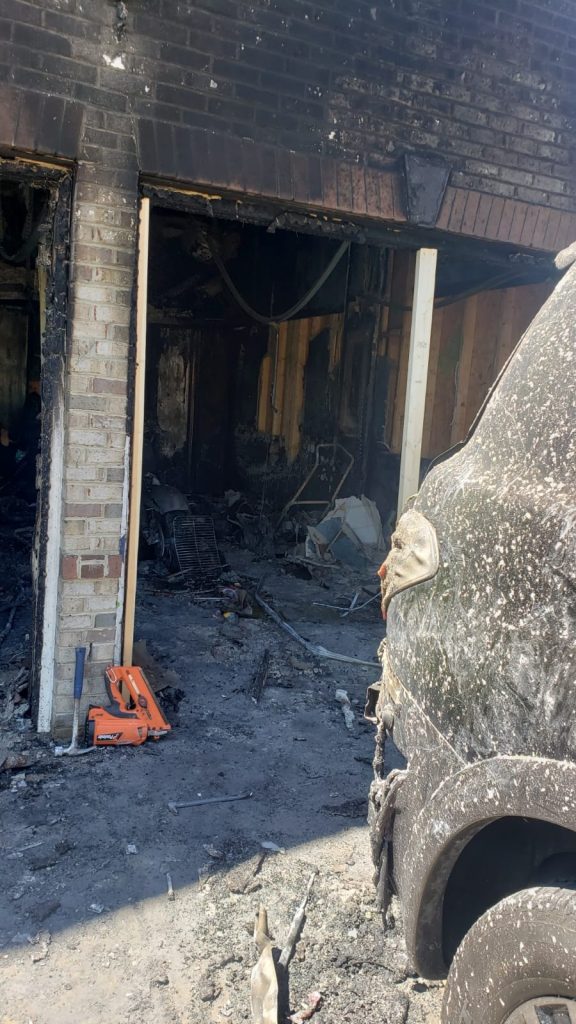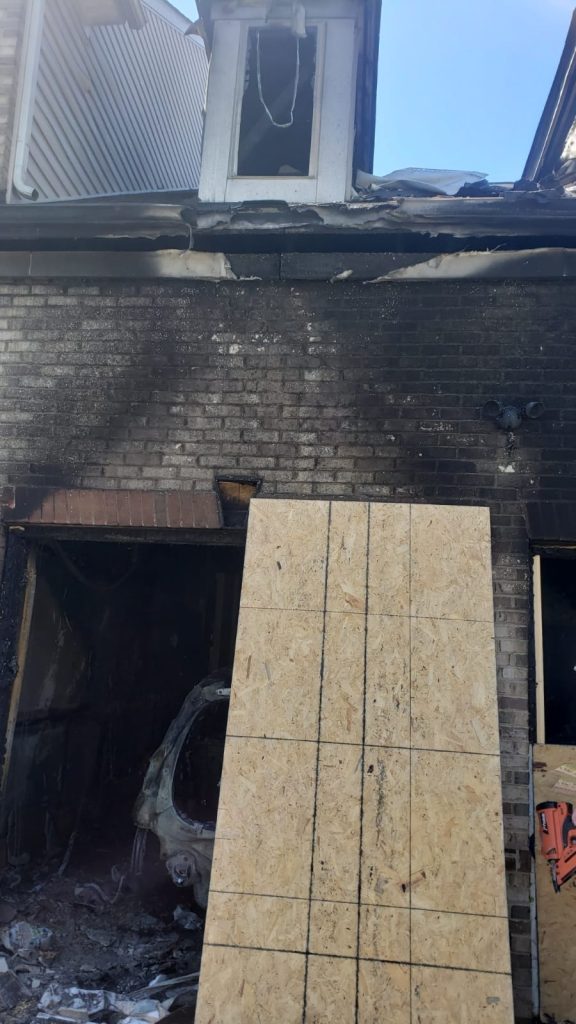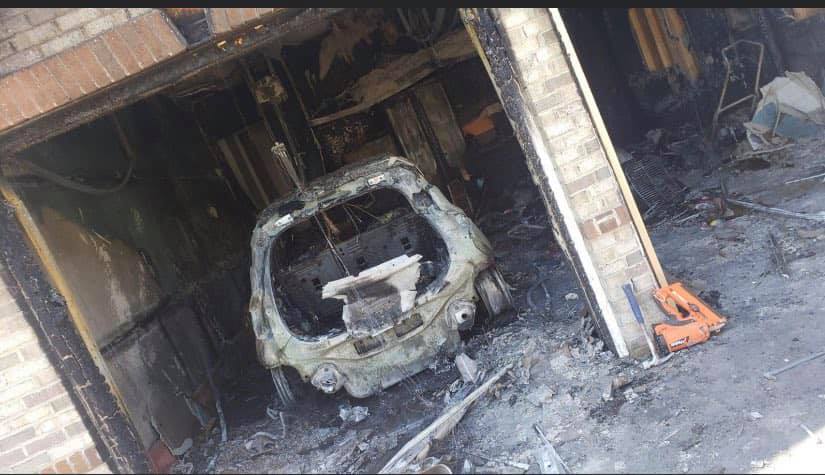
The recent Chevy Bolt fire on May 1, 2021 occurred just days after the “final fix” for the fire issue was announced. We sat down with the owner to discuss what happened, tell the inside story, and try to find some answers…
Our Bolt owner went to his garage at 7:30 on the morning of Saturday, May 1. He unplugged his Chevy Bolt, like he usually does after his infrequent charges. Preferring to charge at night for the cheaper power, he had plugged in it around 2 a.m. since it was below his usual charging threshold of 30 miles remaining. Peering into the window, he noticed it had recharged to about 160 miles of range. That was more than enough for local jaunts. Using his SUV for longer trips, those were the only times he would use the Bolt. Being in IT, he knew that lithium ion batteries didn’t like charging to full, so this was about the same as he usually charged it.
He really loved that car
He took one proud look at his car, still in pristine condition. Despite buying it brand new in December of 2018, his 2019 Chevy Bolt only had 19,000 miles on it. Nary a scratch nor ding blemished it. It was never involved in any accident, and there was no damage to the vehicle at all. He really enjoyed that car; unfortunately, due to the pandemic, he rarely had an opportunity to drive it. When he did drive with his friends, they would always comment about how spacious, zippy, and fun the Bolt was.
He grabbed his coffee and walked out to check the mail and found a recall notification for his Bolt. This was strange because he had already brought it into the Chevrolet dealership on March 25. They told him that it was a one-off recall update to improve charging and reduce fire risk. He made a mental note to call his dealer later in the day to bring it back in. There was no time for that now. Rushing back inside, he sat down at his computer at 8 a.m. on the dot to start his IT training for the day. His kids, wife, and parents were off in the rest of the house, starting their own days as the house buzzed to life. He turned up on the volume on his headset to compensate.
Break Time!
Around 11 a.m., he took a break; getting up from his computer, he noticed that something smelled funny. Not sure what it was, he walked around the house trying to figure it out. It wasn’t coming from the kitchen or the basement. The backyard was clear. But as he approached the garage, the smell became a lot stronger. Opening the garage door, his worst fear was realized – smoke was coming out from his Bolt. Just as he was calling 911, he saw fire erupt from inside coming from the back seat. He could barely talk over the sound of his smoke detectors blaring.
“The fire took off so fast”
Our owner’s take after the fire started
Trying to explain the situation to the emergency responder on the phone, he ran inside to ensure that his family was safe and able to evacuate. His mother tried valiantly to use a fire extinguisher on the flames; it was to no avail, and the fire quickly engulfed the car.
Everyone escaped safely, but from their front lawn, they could see their garage doors crinkle and disappear in flame. Realizing that his SUV, with nearly 20 gallons of gas, was parked right in front of the garage, he became terrified that it would explode. His fatherly instincts kicked in; protecting his family, he retreated to a safe distance while images of their house burning reflected in their teary eyes.
Fire department to the rescue!
Luckily, the Ashburn Volunteer Fire Department and Loudon Fire and Rescue were quick on the scene. At 11:25 a.m., fire and rescue units from Moorefield, Brambleton, Dulles South, Kirkpatrick Farms, Ashburn, Kincora, and multiple command staff officers responded. Having just arrived from a third-floor townhouse fire due to improperly discarded smoking materials, they made quick work of extinguishing the car thanks to copious amounts of water from multiple trucks. Breaking through to the laundry room, the firefighters ensured that there were no other hotspots and left the scene for the investigators.

Unfortunately, the damage was already done. The investigators estimated damages at $235,000, including $85,000 in damages to both vehicles. While the fire damage itself only took out part of the garage and its roof, the copious amounts of water required to put out the battery fire caused flooding throughout the first floor of his house. Later that day, there was still 6″ of water in his basement. His motorcycle, which had also been in the garage, was a burnt carcass.
Overall, he’s very lucky
All told, due to his quick response and the heroic efforts of the fire crews, five adults and two children are safe, and thankfully, nobody was injured. If this had happened overnight, however, it could have been a very different story. It’s estimated that it may be six months before they can return home, as the major water damage will need to be repaired. But at the end of the day, possessions can be replaced, lives can’t; he is happy and feels lucky to be safe with his family while staying with friends.
Key takeaways
We reached out to GM, and they confirmed that they are investigating, but that vehicle has not been released yet. This isn’t unusual – it can take several weeks to a few months depending on the insurance company involved. So no official details are available – this article is based on what the owner told us. The owner had not yet been directly contacted by GM. After confirming with the owner that it was ok, we provided his name and address and phone number to GM – it was not clear if GM already had this. We then confirmed that GM did contact him later that day.
A source at GM also told us something we didn’t know: four of the six other fires had a pattern where the owners would typically run the car low, then charge to full. This is why the temporary fix was to limit the charge to 95% (of previous maximum) to help reduce the risk of fire. Additionally, the temporary fix did not include any additional diagnostics or reporting – it was only a charge limit. There was no lower end limit.
In summary:
- The temporary recall fix had already been applied.
- The owner did not charge to full often, if ever. Even if he did, the initial recall fix would have limited it.
- The car was typically charged when it got down to about 30 miles of range left and stopped between 160-180. That’s about 65-75%.
- The car was rarely used – only 19,000 miles over 2.5 years of ownership.
- There was no damage to the car.
- The car had not been driven that morning, and it was unplugged at around 75% charge.
- The car was unplugged at the time of the fire and had been for several hours.
Electrek’s Take
It should be noted that I am an ardent Bolt fan and have thoroughly enjoyed my Bolt since I purchased it when it first came out. The publisher of this site is also a huge Bolt fan and former 2017 owner.
However, I’m left wondering – will the software fix be enough?
This owner said that he never (or very rarely) charged his car to full, typically only charging to 160-180 miles out of his 240+ available. Although we aren’t sure of his efficiency, since it was only used for local driving and the mileage was so low, he likely had more than the EPA estimated 239 miles of range. That means he only typically charged to around 75%.
What’s critical here is that the fire happened not only with temporary fix applied, but it also actually wasn’t necessary. Clearly the fire can still occur even without the vehicle being at or near full charge.
A trend emerges
If the pieces that we heard are correct, there’s a definite trend. Five of the now seven fires all had charging patterns similar to how people used gas. They let it run down and only charge it once it’s near empty. This sort of cycling is known to be much harder on the battery than shallow discharges. In fact, studies show that shallow discharges with more frequent charges can have significantly less degradation than larger discharges and less frequent charging. This is especially true the higher the state of charge.
But it shouldn’t be dangerous.
With that in mind, here are our recommendations for other owners to reduce their risk, especially if they can’t get the final recall fix applied yet:
- Set a charge limit as low as is reasonable for their daily needs. Ideally no more than 80%, but the lower the better.
- When at home, plug it in. The car will automatically stop charging at the limit; however, leaving it plugged in means that the computers monitor the battery more often than when unplugged.
- Ideally park and charge outside.
- Get the final recall fix applied as soon as possible.
- Do not let the car sit at full charge for long periods of time, and don’t do full cycles unless you absolutely need to.
- Make sure that you have a smoke detector in your garage – bonus if it’s a smart one that can alert you.
Theoretically, the new recall software fix that is now live for 2019 Bolts like this one, and subsequent fixes for 2017 and 2018 Bolts should be able to detect packs that are in danger of catching fire.
Hopefully, we get additional clarity from GM in the coming weeks.
FTC: We use income earning auto affiliate links. More.








Comments